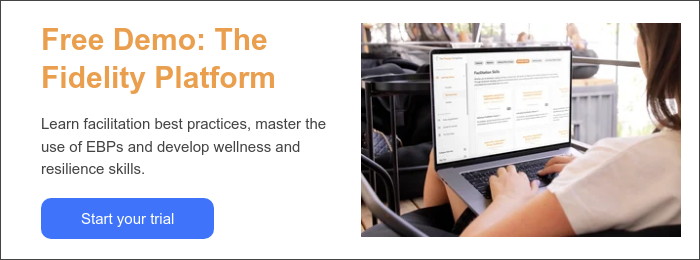Interactive Journaling®: Distinctive Roles

The evidence-based practice of Interactive Journaling® has been researched both as a self-directed resource (Proctor et al., 2012) and as part of structured group programming (Moore, 2011), demonstrating its efficacy as a standalone intervention as well as a supportive tool for building the therapeutic alliance. So what roles are being played by Interactive Journals in moving someone toward positive change? What makes these roles distinct from those of a skilled facilitator? These roles are described below.
1. Structured expressive writing
Expressive writing is an approach in which individuals write their deepest thoughts and feelings about a specific event, exploring the experience itself alongside the thoughts and emotions surrounding it (Pennebaker & Chung, 2012; Pennebaker & Smyth, 2016). Research has connected expressive writing to a number of positive physical and mental health outcomes, including improved sleep (Smyth et al., 2011), cardiovascular functioning (McGuire et al., 2005), life satisfaction and subjective well-being (Schutte et al., 2012), reduction in self-reported depression (Smyth et al., 2011) and increased emotional self-regulation (Davidson et al., 2002).
The practice of Interactive Journaling® differs from standard expressive practices in which a person records their thoughts and feelings freely in a notebook or diary. Rather, the structured format of Interactive Journals allows for the provision of relevant information and reflective questions on each page, guiding participants toward insights in the target need area.
For example, a page in a Journal about evidence-based processes of change (see Prochaska & Prochaska, 2016) might briefly describe research on people’s ability to make difficult, long-term life changes. The questions on the page would allow the reader to reflect on how this holds true for them. For example, “Describe a time you were successful at making a change,” “What did you do to be successful?” and “What were some small steps that brought you closer to that change?” Finally, the graphic on the page might feature a road or a pathway, illustrating the concept of change as an ongoing journey.
2. Extratherapeutic functionality
Research has long demonstrated that roughly 30% of a person’s change process can be attributed to the therapeutic relationship, while extratherapeutic factors are estimated to contribute 40% to change (Thomas, 2006). These factors include components like the person’s strengths, their support system, their environment and the situations they encounter on a day-to-day basis.
Because Interactive Journals go directly into the hands participants, there is flexibility in where and when each exercise might be completed. This makes them an excellent tool for extratherapeutic skill-building. Additionally, the Journals emphasize personal strengths and self-efficacy, providing vital reminders in the absence of a practitioner or facilitator.
Finally, Interactive Journals allow individuals to increase self-awareness and commitments to change at their own pace. They can teach vital well-being skills and coping mechanisms without necessitating the presence of a professional (L’Abate & Kern, 2002).
3. Sense of permanence
The permanent messaging of printed Journals may offer greater clarity to participants, compared with relying on, listening to, understanding and integrating a practitioner’s advice in the moment. Interactive Journals are also unique in that they are always published using complete, high-quality, full-color design, differentiating them from workbook PDFs that can be printed from the internet or loose-leaf sheets compiled into a binder. A number of individuals who have participated in Interactive Journaling® have expressed the value of keeping a permanent, lasting resource in which to record their personal journeys of change. In an anonymous survey of self-reported feedback from 27,066 Interactive Journaling® participants in Alaska, Kentucky, New Mexico, Oklahoma, Vermont, Washington and Wisconsin, 84 percent of respondents said they planned to keep their Journals after completing the formal courses in which they were administered (The Change Companies, n.d.-a).
4. Strategic evocation of change talk
Motivational interviewing is a way of communicating (verbally or through written prompts) that elicits an individual’s own motivation to change by encouraging the use of “change talk” regarding a target behavior. Change talk is language that expresses a person’s desire, ability, reason or need to change (the acronym DARN) (Moyers et al., 2009). Change talk can be elicited using questions like, “What are three reasons making this change is important to you?” or “Based on what you know about yourself and your abilities, what might you do to be successful at this?” (Miller & Rollnick, 2013). While motivational interviewing is traditionally used in clinical, face-to-face settings, Interactive Journaling® also encourages change talk by posing reflective questions on each page. In this way, Interactive Journals serve a “partnership role,” working in tandem with facilitators who are skilled in motivational interviewing techniques. For those with less training in this modality, Facilitator Guides offer hints on appropriate times to pose motivational interviewing-style questions throughout a session.
5. Visual walkthroughs of cognitive-behavioral principles
Cognitive-behavioral therapy strives to increase a person’s awareness of their own cognitive distortions and teach them how to investigate, reappraise and challenge inaccurate and unhelpful biases (Beck & Dozois, 2011). Cognitive-behavioral therapy underpins Interactive Journaling®. In some cases, cognitive-behavioral skill-building is the primary focus of an entire Interactive Journal. In other cases, Interactive Journals will address another topic and use cognitive-behavioral skills to enhance participants’ competency in the target area. Whether exploring cognitive-behavioral therapy at a more comprehensive level or simply helping participants recognize how their thoughts may be affecting their outcomes, most Interactive Journals use a cognitive-behavioral approach to guide individuals toward more helpful and accurate thinking patterns. As with motivational interviewing, this role can be played in “partnership” with facilitators with training in cognitive-behavioral approaches. For those with less training in this modality, Facilitator Guides offer guidance on key terms, frameworks and facilitation approaches for delivering and practicing cognitive-behavioral skills.
6. Can serve as a vehicle for other therapeutic modalities
The formatting of Interactive Journals makes this practice a prime candidate for user-friendly delivery of evidence-based therapies and psychological interventions.
The structure of Interactive Journals means that even if a coach, therapist or other practitioner has not been trained in a specific modality or need area, they can administer an Interactive Journal that addresses it efficaciously. An Interactive Journal may incorporate any number of evidence-based frameworks into its pages, insofar as these frameworks are in service of the target change and conducive to the reflective writing format of Interactive Journaling®.
References
Beck, A. T., & Dozois, D. J. (2011). Cognitive therapy: Current status and future directions. Annual Review of Medicine, 62, 397-409.
Davidson, K., Shwartz, A. R., Scheffield, D., McCord, R. S., Lepore, S. J., & Gerin, W. (2002). Expressive writing and blood pressure. In S. J. Lepore & J. M. Smyth (Eds.), The writing cure: How expressive writing promotes health and emotional well-being (p. 17-30). American Psychological Association.
L’Abate, L. & Kern, R. (2002). Workbooks: Tools for the expressive writing paradigm. In S. J. Lepore & J. M. Smyth (Eds.), The writing cure: How expressive writing promotes health and emotional well-being. American Psychological Association.
McGuire, K. M. B., Greenberg, M. A., & Gevirtz, R. (2005). Autonomic effects of expressive writing in individuals with elevated blood pressure. Journal of Health Psychology, 10, 197-207.
Miller, W. R., & Rollnick, S. (2013). Motivational interviewing: Helping people change (3rd ed.). The Guilford Press.
Moore, M. J. (2011). Examining participants’ motivation to change in Residential Drug Abuse Program graduates: Comparing “stages of change” assessment data with post-release status [Doctoral dissertation, University of Minnesota].
Moyers, T. B., Martin, T., Houck, J. M., Christopher, P. J., & Tonigan, J. S. (2009). From in-session behaviors to drinking outcomes: A causal chain for motivational interviewing. Journal of Consulting and Clinical Psychology, 77(6), 1113-1124
Pennebaker, J. W., & Chung, C. K. (2012). Expressive writing: Connections to physical and mental health. In H. S. Friedman (Ed.), The Oxford handbook of health psychology. Oxford University Press.
Pennebaker, J. W., & Smyth, J. M. (2016). Opening up by writing it down: How expressive writing improves health and eases emotional pain. Guilford.
Prochaska, J. O., & Prochaska, J. M. (2016). Changing to thrive: Using the stages of change to overcome the top threats to your health and happiness. Hazelden.
Proctor, S. L., Hoffmann, N. G., & Allison, S. (2012). The effectiveness of interactive journaling in reducing recidivism among substance-dependent jail inmates. International Journal of Offender Therapy and Comparative Criminology, 56(2), 317-332.
Schutte, N. S., Searle, T., Meade, S., & Dark, N. A. (2012). The effect of meaningfulness and integrative processing in expressive writing on positive and negative affect and life satisfaction. Cognition & Emotion, 26(1), 144-152.
Smyth, J. M., Pennebaker, J. W., & Arigo, D. (2011). What are the health effects of disclosure? In A. Baum, T. A. Revenson, & J. Singer (Eds.), Handbook of health psychology (2nd ed., pp. 175-191). Routledge.
Thomas, M. L. (2006). The contributing factors of change in therapeutic factors. Contemporary Family Therapy, 28, 201-210.
The Change Companies (n.d.-a). Participant feedback data on using Interactive Journaling. The Change Companies.

